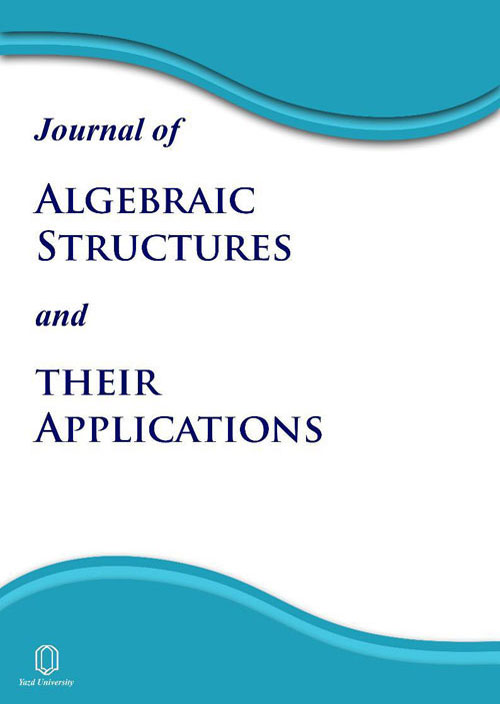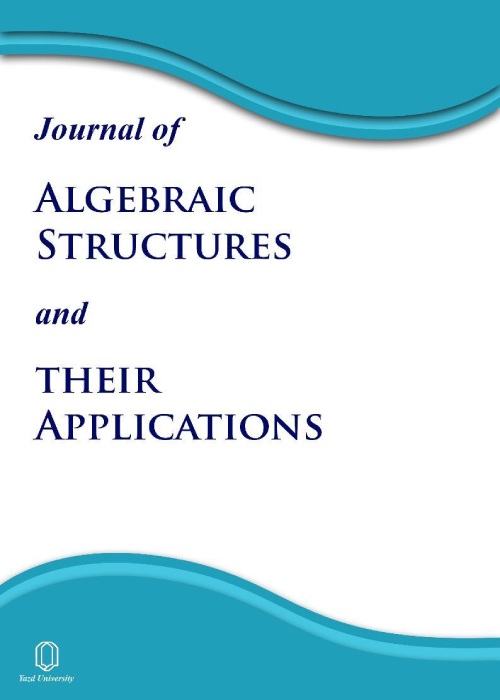فهرست مطالب

Journal of Algebraic Structures and Their Applications
Volume:8 Issue: 2, Summer-Autumn 2021
- تاریخ انتشار: 1400/05/17
- تعداد عناوین: 12
-
-
Pages 1-15
The concept of Faltings' local-global principle for CD<n of local cohomology modules over a Noetherian ring R is introduced, and it is shown that this principle holds at levels 1, 2 over local rings. We also establish the same principle at all levels over an arbitrary Noetherian local ring of dimension not exceeding 3. These generalize the main results of Brodmann et al. in [9].
Keywords: CD<n R-modules, Local cohomology modules, Local-global principle -
Pages 17-30
Suppose that G is a groupoid with binary operation ⊗. The pair (G,⊗) is said to be a gyrogroup if the operation ⊗ has a left identity, each element a∈G has a left inverse and the left gyroassociative law and the left loop property are satisfied in G. In this paper, a method for constructing new gyrogroups from old ones is presented and the structure of subgyrogroups of these gyrogroups are also given. As a consequence of this work, five 2−gyrogroups of order 2n, n≥3, are presented. Some open questions are also proposed.
Keywords: Gyrogroup, subgyrogroup, groupoid -
Pages 31-49
A finite group G is called \textit{(l,m,n)-generated}, if it is a quotient group of the triangle group T(l,m,n)=⟨x,y,z|xl=ym=zn=xyz=1⟩. In 29, Moori posed the question of finding all the (p,q,r) triples, where p, q and r are prime numbers, such that a non-abelian finite simple group G is a (p,q,r)-generated. In this paper we establish all the (p,q,r)-generations of the symplectic group Sp(6,2). GAP 20 and the Atlas of finite group representations 33 are used in our computations.
Keywords: Conjugacy classes, generation, simple groups, structure constants, symplectic groups -
Pages 51-65
For a group G, πe(G) and sm(G) are denoted the set of orders of elements and the number of elements of order m in G, respectively. Let nse(G)={sm(G) | m∈πe(G)}. An arbitrary finite group M is NSE characterization if, for every group G, the equality nse(G)=nse(M) implies that G≅M. In this paper, we are going to show that the non-Abelian finite simple groups A9, A10, A12, U4(3), U5(2), U6(2), S6(2), O+8(2) and HS are characterizable by NSE.
Keywords: Element order, finite simple group, prime graph -
Pages 67-118
The commuting conjugacy class graph of a non-abelian group G, denoted by CCC(G), is a simple undirected graph whose vertex set is the set of conjugacy classes of the non-central elements of G and two distinct vertices xG and yG are adjacent if there exists some elements x′∈xG and y′∈yG such that x′y′=y′x′. In this paper we compute various spectra and energies of commuting conjugacy class graph of the groups D2n,Q4m,U(n,m),V8n and SD8n. Our computation shows that CCC(G) is super integral for these groups. We compare various energies and as a consequence it is observed that CCC(G) satisfy E-LE Conjecture of Gutman et al. We also provide negative answer to a question posed by Dutta et al. comparing Laplacian and Signless Laplacian energy. Finally, we conclude this paper by characterizing the above mentioned groups G such that CCC(G) is hyperenergetic, L-hyperenergetic or Q-hyperenergetic.
Keywords: commuting conjugacy class graph, spectrum, energy, finite group -
Pages 119-129
In this article,we give a characterization of containment of subgroups in a direct product A×B×C. Other potential generalizations are investigated and applications characterizing different types of groups and modules are given. Most of applications are simple while somewhat deeper applications occur in the case of cyclic modules.
Keywords: Goursat Lemma, Groups, Permutable subgroups, Cyclic modules -
Pages 131-143
In this article, we study connections between components of the Cayley graph Cay(G,A), where A is an arbitrary subset of a group G, and cosets of the subgroup of G generated by A. In particular, we show how to construct generating sets of G if Cay(G,A) has finitely many components. Furthermore, we provide an algorithm for finding minimal generating sets of finite groups using their Cayley graphs.
Keywords: Cayley graph, Connected graph, Coset, Generating set, Graph component -
Pages 145-155
In this paper, we introduce a notion of ultra central approximate identity for Banach algebras which is a generalization of the bounded approximate identity and the central approximate identity. Using this concept we study pseudo-contractibility of some matrix algebras among ℓ1-Munn algebras. As an application, for the Brandt semigroup S=M0(G,I) over a non-empty set I, we show that ℓ1(S) has an ultra central approximate identity if and only if I is finite. Also we show that the notion of pseudo-contractibility and contractibility are the same on ℓ1(S)∗∗, where S is the Brandt semigroup.
Keywords: Semigroup algebras, Ultra central approximate identity, Locally finite inverse semigroup, Pseudo-contractibility, Matrix algebras -
Pages 157-175
The aim of this article is to study ordered semihypergroups in the framework of (M,N)-int-soft bi-hyperideals. In this paper, we introduce the notion of (M,N)-int-soft bi-hyperideals\ of ordered semihypergroups. Some properties of (M,N)-int-soft bi-hyperideals in ordered semihypergroups are provided. We show that every int-soft bi-hyperideal is an (M,N)-int-soft bi-hyperideals of S over U but the converse is not true which is shown with help of an example. We characterize left (M,N) simple and completely regular ordered semihypergroups by means of (M,N)-int-soft bi-hyperideals.The aim of this article is to study ordered semihypergroups in the framework of (M,N)-int-soft bi-hyperideals. In this paper, we introduce the notion of (M,N)-int-soft bi-hyperideals of ordered semihypergroups. Some properties of (M,N)-int-soft bi-hyperideals in ordered semihypergroups are provided. We show that every int-soft bi-hyperideal is an (M,N)-int-soft bi-hyperideals of S over U but the converse is not true which is shown with help of an example. We characterize left (resp. right) simple and completely regular ordered semihypergroups by means of (M,N)-int-soft bi-hyperideals.
Keywords: Int-soft hyperideal, int-soft bi-hyperideal, (M, N)-int-soft bi-hyperideal -
Pages 177-194
This paper studies homoderivations satisfying certain conditions on semigroup ideals of near-rings. In addition, we include some examples of the necessity of the hypotheses used in our results.
Keywords: 3-prime Near-ring, Homoderivation, Zero-power valued mappings, Semigroup ideal, Commutativity theorems -
Pages 195-201
Let G be a group with identity e. Let R be a G-graded commutative ring with identity 1 and M a graded R-module. A proper graded submodule C of M is called a graded classical prime submodule if whenever r,s∈h(R) and m∈h(M) with rsm∈C, then either rm∈C or sm∈C. In this paper, we introduce the concept of graded Jgr-classical prime submodule as a new generalization of graded classical submodule and we give some results concerning such graded modules. We say that a proper graded submodule N of M is \textit{a graded }Jgr\textit{-classical prime submodule of \ }M if whenever rsm∈N where r,s∈h(R) and m∈h(M), then either rm∈N+Jgr(M) or sm∈N+Jgr(M), where Jgr(M) is the graded Jacobson radical.
Keywords: Graded Jgr-classical prime submodule, Graded classical prime submodule, Graded prime -
Pages 203-222
A vague graph is a generalized structure of a fuzzy graph that gives more precision, flexibility and compatibility to a system when compared with systems that are designed using fuzzy graphs. In this paper, the notions of (perfect-total) 2-dominating set and (perfect-total) 2-domination numbers on vague graphs are introduced and some properties are investigated. Especially, it is proven that in any strong vague graph on a Petersen graph, any minimal 2-dominating set is a minimal perfect 2-dominating set and minimal dominating set. Then, the concepts of (total) 2-cobondage set and (total) 2-cobondage number in vague graphs are expressed and related results obtained. Finally, an application related to Fire Stations and Emergency Medical centers is provided.
Keywords: Vague graph, 2-dominating set, 2-cobondage set


